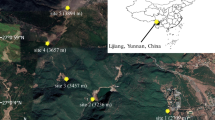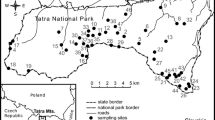Summary
In a riparian population of Erythronium americanum (Liliaceae) in central New Jersey, experimentally self-pollinated plant produced markedly fewer fruit and fewer seeds per fruit than hand-outcrossed and open pollinated plants, even though differences were not evident between pollen tubes that penetrated stigmas from self or foreign pollen. This weak self-compatibility and a positive relation between the percentage of seeds set by outcrossed plants and the distance between pollen donor and recipient plants indicate that this population could be susceptible to inbreeding depression.
Limited resources for seed development apparently constrained maximal seed production, based on low seed set (40.6%) by hand-pollinated plants and positive correlations for these plants between plant size and the number and size of seeds set. In contrast, naturally-pollinated plants set a smaller proportion of their ovules, suggesting that limited pollinator service reduced the quantity of seeds produced in this population. Free-foraging bees usually removed more than half of the available pollen in a single visit, so that individual plants probably have few opportunities to disseminate their pollen.
Even though sexually reproductive ramets produce only a single flower per year, less than a third of variation in floral morphology is associated with variation in plant size. Within the flower, the sizes of some closely associated structures, such as the style and ovary, and the anthers and filaments, vary essentially independently of one another. Production of nectar and pollen, the ultimate attractors of pollinating insects, was positively correlated with flower size.
Similar content being viewed by others
References
Antonovics J, Primack RB (1982) Experimental ecological genetics in Plantago. VI. The demography of seedling transplants of P. lanceolata. J Ecol 70:55–75
Bernhardt P (1977) The pollination ecology of a population of Erythronium americanum Ker. (Liliaceae). Rhodora 79:278–282
Blodgett FH (1894) On the development of the bulb of the adder's tongue. Bot Gaz 19:61–65
Breese EL (1959) Selection for differing degrees of out-breeding in Nicotiana rustica. Ann Bot 23:331–344
Draper NR, Smith H (1981) Applied regression analysis, ed. 2. Wiley, New York
Grant KA, Grant V (1968) Hummingbirds and their flowers. Columbia Univ Press, New York
Grant V, Grant KA (1965) Flower pollination in the Phlox family. Columbia Univ Press, New York
Harder LD (1983) Flower handling efficiency of bumble bees: morphological aspects of probing time. Oecologia (Berlin) 57:274–280
Haynes J, Mesler M (1984) Pollen foraging by bumblebees: Foraging patterns and efficiency on Lupinus polyphyllus. Oecologia (Berlin) 61:249–253
Holland PG (1981) The demography of trout lily (Erythronium americanum Ker.) in Nova Scotia. Vegetatio 45:97–106
Janzen DH (1977) A note on optimal mate selection by plants. Am Nat 111:365–371
Janzen DH (1983) Seed and pollen dispersal by animals: convergence in the ecology of contamination and sloppy harvest. Biol J Linnean Soc 20:103–113
Jones CE, Little RJ (1983) Handbook of experimental pollination biology. Van Nostrand Reinhold, New York
Kawano S, Hiratsuka A, Hayashi K (1982) Life history characteristics and survivorship of Erythronium japonicum. Oikos 38:129–149
Lloyd DG, Yates JMA (1982) Intrasexual selection and the segregation of pollen and stigmas in hermaphrodite plants, exemplified by Wahlenbergia albomarginata (Campanulaceae). Evolution 36:903–913
Macior LW (1982) Plant community and pollinator dynamics in the evolution of pollination mechanisms in Pedicularis (Scrophulariaceae). In: JA Armstrong, JM Powell, AJ Richards (ed) Pollination and evolution. Royal Botanic Gardens, Sydney, pp 29–45
Morse DH (1978) Size-related foraging differences of bumble bee workers. Ecol Ent 3:189–192
Motten AF (1983) Reproduction of Erythronium umbilicatum (Liliaceae): pollination success and pollinator effectiveness. Oecologia (Berlin) 59:351–359
Muller J (1979) Form and function in angiosperm pollen. Ann Missouri Bot Gard 66:593–632
de Nettancourt D (1977) Incompatibility in angiosperms. Springer, Berlin Heidelberg New York Tokyo
Parks CR, Hardin JW (1963) Yellow erythroniums of the eastern United States. Brittonia 15:245–259
Price MV, Waser NM (1979) Pollen dispersal and optimal outcrossing in Delphinium nelsonii. Nature 277:294–297
Primack RB, Silander JA (1975) Measuring the relative importance of different pollinators to plants. Nature 255:143–144
Real L (1983) Pollination biology. Academic Press, New York
Richards JH, Barrett SCH (1984) The developmental basis of tristyly in Eichornia paniculata (Pontederiaceae). Am J Bot 71:1347–1363
Schemske DW, Willson MF, Melampy MN, Miller LJ, Verner L, Schemske KM, Best LB (1978) Flowering ecology of some spring woodland herbs. Ecology 59:351–366
Schoen DJ (1982) The breeding system of Gilia achilleifolia: variation in floral characteristics and outcrossing rate. Evolution 36:352–360
Strickler K (1979) Specialization and foraging efficiency of solitary bees. Ecology 60:998–1009
Thomson JD (in press) Pollen transport and deposition by bumble bees in Erythronium: influences of floral nectar and bee grooming. J Ecol
Thomson JD, Barrett SCH (1981) Temporal variation of gender in Aralia hispida Vent. (Araliaceae). Evolution 35:1094–1107
Thomson JD, Plowright RC (1980) Pollen carryover, nectar rewards, and pollinator behavior with special reference to Diervilla lonicera. Oecologia (Berlin) 46:68–74
Thomson JD, Stratton DA (1985) Floral morphology and outcrossing in Erythronium grandiflorum. Am J Bot 72:433–437
Waser NM, Price MV (1983) Optimal and actual outcrossing in plants, and the nature of plant-pollinator interaction. In: CE Jones, RJ Little (ed) Handbook of experimental pollination biology. Van Nostrand Reinhold, New York, pp 341–359
Waser NM, Price MV (1984) Experimental studies of pollen carryover: effects of floral variability in Ipomopsis aggregata. Oecologia (Berlin) 62:262–268
Webb CJ, Bawa KS (1984) Pollen dispersal by humingbirds and butterflies: a comparative study of two lowland tropical plants. Evolution 37:1258–1270
Wolfe LM (1983) The effect of plant size on reproductive characteristics in Erythronium americanum (Liliaceae). Can J Bot 61:3489–3493
Author information
Authors and Affiliations
Rights and permissions
About this article
Cite this article
Harder, L.D., Thomson, J.D., Cruzan, M.B. et al. Sexual reproduction and variation in floral morphology in an ephemeral vernal lily, Eyythronium americanum . Oecologia 67, 286–291 (1985). https://doi.org/10.1007/BF00384301
Received:
Issue Date:
DOI: https://doi.org/10.1007/BF00384301




